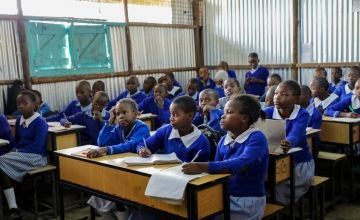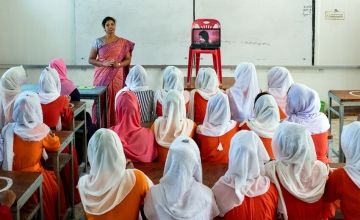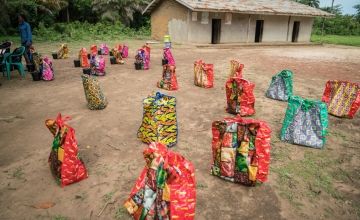
Knowledge Hub
What is period poverty and how can we end it?

Period poverty is defined by the inability to afford or access menstrual products, hygiene facilities, safe waste management, and timely education on menstruation and menstrual health.
Period poverty affects women, girls and people who menstruate across the world. Anyone who has a period requires access to menstrual products, hygienic spaces to use them and the right to manage their menstrual period without shame or stigma.
Period poverty facts and statistics
- On any given day, more than 300 million women worldwide are menstruating - an estimated 500 million lack access to menstrual products and adequate facilities for menstrual hygiene management (World Bank 2022)
- 1.25 billion women and girls have no access to a safe and private toilet (UN Women 2019)
- In South Sudan, 57 percent of surveyed adolescent girls reported staying home during menstruation because of the lack of private changing rooms in school (Tamiru et al. 2015)
What are the causes of period poverty?
Cultural causes of period poverty
Period poverty is largely driven by cultural factors that stigmatise menstruation. Across several cultures the menstrual stigma is a perception that menstruation is a “dirty” or “impure” thing that needs to be kept in private. In many conservative societies, religious and cultural taboos often force women into seclusion during their periods and myths and shame can lead to women and girls being reluctant to discuss how to access sanitary products or have open discussions about their menstrual health.
These cultural obstacles create an environment where harmful and sexist beliefs can flourish, which can lead to communities having misconceptions about menstruation. For example, many women and girls within these communities lack knowledge of why menstruation occurs and also suffer from stigmas which characterise women as ‘irrational’ or ‘hysterical’ during menstruation which shapes how they participate in public life. The ignorance driven by these misogynistic biases creates environments where menstrual health education is abysmal, which impacts women’s long-term health.
Period poverty and infrastructure
Additionally, economic vulnerability and inadequate infrastructure poses specific challenges for menstruating women and young girls. In many parts of the world, water and sanitation facilities are severely underfunded and underdeveloped. Around 2.3 billion people worldwide lack access to basic sanitation services. Homes, schools, or workplaces in many low-income countries lack clean toilets and water, as well as access to menstrual products, such as pads, tampons, or menstrual cups, which increases the risk of women suffering bacterial infections as a result. According to some studies, in some cases, women in poor communities have chosen pregnancy to avoid menses as they lack the means to purchase hygiene menstrual products.
Period poverty around the world
Period poverty remains an issue globally, affecting low-income communities in more wealthy western countries, to significantly impacting vulnerable communities in low-income countries.
In 2023, a study of 107 countries examined the combined local cost (in USD) of a one-month supply of menstrual products and ibuprofen medication to measure period poverty on an international level. Researchers looked at affordability by finding the cheapest listed price of the products available online in each country and compared them to the per-capita income of the average resident in the country.
These are the following countries that rank most poorly for cost of menstrual products and the relative percentages of the monthly incomes:
1. Algeria (14.8%)
2 (tie). Zambia (10.93%)
2 (tie). Nigeria (10.93%)
4. Ghana (9.39%)
5. Zimbabwe (9.27%)
6. Kyrgyzstan (9.05%)
7. Honduras (8.54%)
8. Jordan (8.38%)
9. Laos (8.33%)
10. Cambodia (7.74%)
What does period poverty mean for the world’s most vulnerable communities?
Who does period poverty affect?
While period poverty affects people in both lower and higher income countries, those in poorer countries are disproportionately affected, particularly in countries where menstruation products are largely imported. This is because they face the double challenge of a lower-income and sometimes shockingly expensive period products.
This can lead to dangerous coping mechanisms, such as having transactional sex to obtain pads. This is particularly prevalent in remote areas where access to items isn’t available – for example small villages with no roads or bus services. In other instances, menstruators will resort to using unhygienic alternatives to pads, such as rags and leaves.
What are the effects of period poverty?
Good menstrual hygiene management plays a fundamental role in enabling women, girls, and other menstruators to reach their full potential. In its absence, when women and girls experience period poverty, the effects are far reaching, cutting across a number of areas.
How does period poverty affect education?

We know that girls who experience period poverty are more likely to miss essential education for a number of reasons, ranging from not wanting to bleed through clothes in public, to health problems or a lack of facilities at school.
Girls who drop out of school have less opportunity for employment and will often marry early and have children young, which further reduces their potential to earn an income.
Education period poverty facts and statistics
- In low-income countries, half of the schools lack adequate water, sanitation, and hygiene services crucial to enable girls and female teachers to manage menstruation (UNICEF 2015)
- A study of adolescent girls in India found that a quarter of the girls did not attend school during menstruation because of the lack of adequate toilets (Van Eijk et al. 2016)
- A study in Kenya found that 95 percent of menstruating girls missed one to three school days a month, 70 percent reported a negative impact on their grades, and more than 50 percent stated falling behind in school because of menstruation (Mucherah and Thomas 2017)
- A survey in Bangladesh found that only 6 percent of schools provide education on health and hygiene, and only 36 percent of girls had prior knowledge about menstruation before their first period (World Bank 2017)
The effects of period poverty on health
Without adequate access to menstrual products, such as pads and tampons, some people who menstruate are forced to resort to using alternatives, such as dirty rags, leaves, nappies, newspapers, mud and chicken feathers during their periods. There are also many places in the world where people do not have access to clean water and some countries where female genital mutilation (FGM) still takes place. All of these factors put menstruators at an increased risk of infection and other medical problems while managing their periods. These health risks can also result in infertility or birth complications.
Where people struggle to afford period products, they may try to avoid menstruation all together by taking medication or skipping meals, creating both health problems and negative attitudes towards food.
Studies have found that giving out sanitary pads to girls leads to a significant reduction in sexually transmitted infections and bacterial vaginosis (Benshaul Tolonen et al. 2019; Phillips-Howard et al. 2016.
Why addressing period poverty is good for the economy
Period poverty has far reaching effects that go beyond the individuals affected. The knock-on effect of missing education due to period poverty means that there are less opportunities open to those who menstruate and they are more likely to stay at home.
Those who do work but don’t have access to menstruation-friendly facilities lose wages for days they miss. Their potential is also often unrealised as they are viewed as unreliable and overlooked when it comes to promotions. If we can address this, we open the door to much larger contributions to the greater economy.
What is Concern doing to help to end period poverty?

Concern supports people who menstruate in a number of different ways.
Many communities we work with are forced to leave their homes to stay safe due to conflict or climate change. Displaced women and girls struggle to meet their menstrual hygiene needs, often living in tough environments with poor access to safe water and adequate sanitation. In emergencies, we often provide water and facilitate building of latrines which helps people manage their period hygienically. Additionally, dignity and hygiene kits are distributed, containing essential items to manage periods.
We also support women and girls to make their own reusable sanitary pads. In Rohingya refugee camps we have women-led community centres where women can learn a skill, including tailoring so they can produce their own sanitary pads. Similarly, in Sub-Saharan Africa, we support school-girls to make their own pads so they don’t have to miss school.
In Sierra Leone, we are providing menstrual hygiene sessions and have reached 9,200 women, girls and boys with information and re-usable sanitary pads, as well as 1,200 parents and husbands with sessions to improve relationships between adolescents and their parents, encouraging more open conversations on sexual and reproductive health.
On a broader scale, Concern has produced publications, such as a menstrual health management manual in Democratic People's Republic of Korea, that has engaged ministries and local institutions, and has been fundamental to highlighting these issues at policy level.
Menstrual Hygiene Day

May 28th is Menstrual Hygiene Day, marked globally
The overarching theme for 2024 is ‘Together for a #PeriodFriendlyWorld’, aiming towards making menstruation a normal fact of life by 2030.
Commitment to both action and funding must remain high on the menstrual health and hygiene agenda in all countries.
Every day is menstrual hygiene day for those who are menstruating, and from Afghanistan to South Sudan to Ukraine, Concern Worldwide is supporting poorest women and girls who lack essential menstrual hygiene materials and resources.
Other ways to help
Donate now
Give a one-off, or a monthly, donation today.
Join an event
From mountain trekking to marathon running, join us for one of our many exciting outdoor events!
Buy a gift
With an extensive range of alternative gifts, we have something to suit everybody.
Leave a gift in your will
Leave the world a better place with a life-changing legacy.
Become a corporate supporter
We partner with a range of organisations that share our passion and the results have been fantastic.
Create your own fundraising event
Raise money for Concern by organising your own charity fundraising event.


